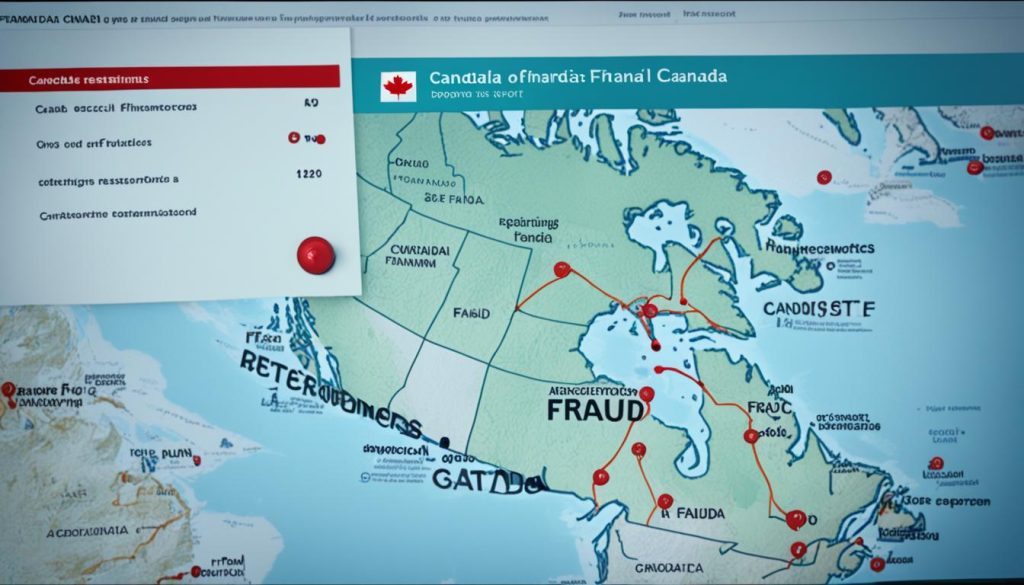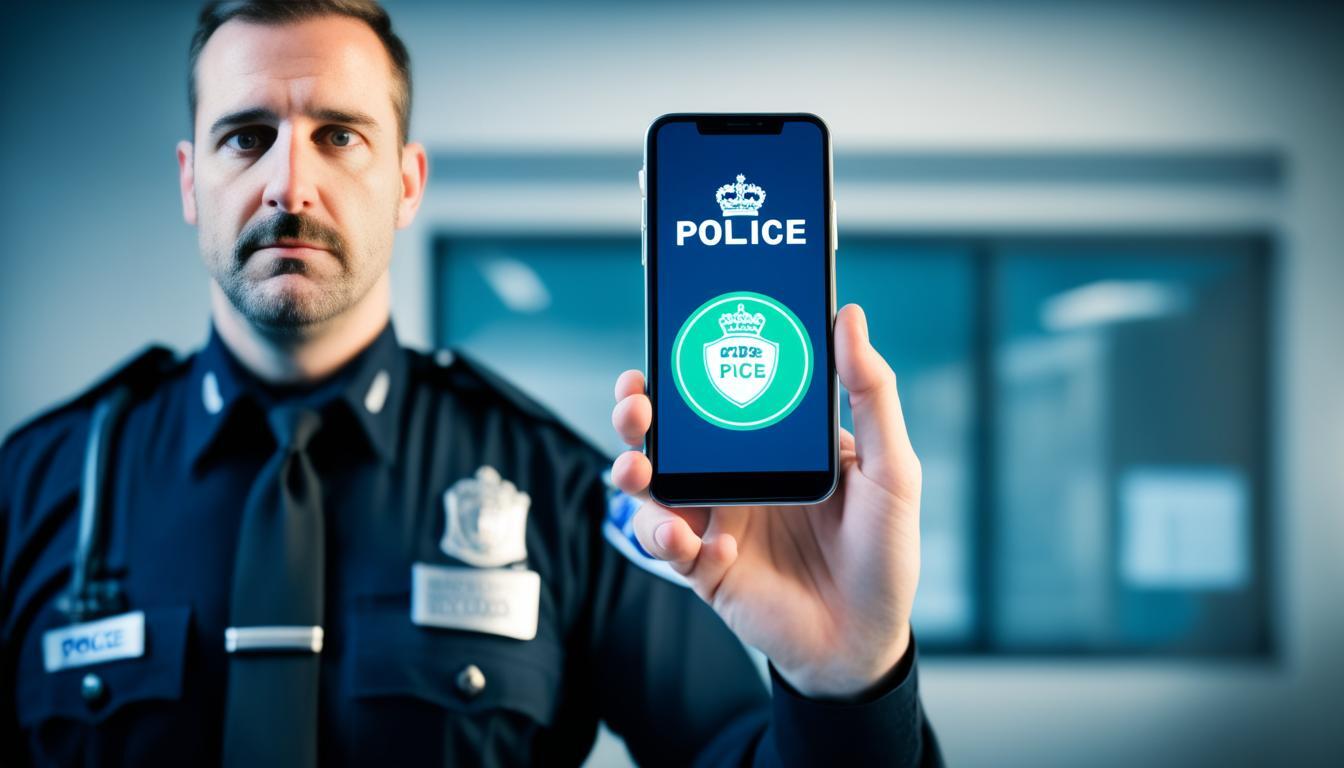Report a Scammer in Canada: Quick Guide
Reporting scams and fraud is crucial in Canada to protect yourself and help prevent others from falling victim. Whether you have been targeted or have witnessed fraudulent activity, it is important to know how to report a scammer. By reporting the incident, you provide law enforcement with the information they need to investigate and take action. This section will provide a step-by-step guide on how to report a scammer in Canada, including reporting online, by phone, and the importance of reporting fraud.
Key Takeaways:
- Knowing how to report a scammer is essential for protecting yourself and others from falling victim to fraud in Canada.
- Reporting scams and fraud provides valuable information to law enforcement, helping them to investigate and take action against scammers.
- The Canadian Anti-Fraud Centre (CAFC) is a central hub for reporting scams and fraud in Canada, offering online and phone reporting options.
- Reporting fraud and cybercrime contributes to the fight against fraud, helps identify crime trends, and supports prevention and awareness efforts.
- Gathering information about the scam and reporting to local law enforcement is crucial in ensuring appropriate action is taken.
- Notifying financial institutions and websites where the fraudulent activity took place helps protect your accounts and prevents further scams.
- Recognizing the signs of a scam and protecting your personal information are essential for avoiding fraud and staying safe online.
Reporting to the Canadian Anti-Fraud Centre
When it comes to reporting scams and fraud in Canada, the Canadian Anti-Fraud Centre (CAFC) is your go-to resource. As a central hub for scam and fraud reporting, the CAFC plays a crucial role in assisting law enforcement agencies by maintaining a repository of valuable information that aids in investigations.
To report a scam or fraud to the CAFC, you have two options: reporting online or reporting by phone.
To report online, you can use the CAFC’s secure reporting system accessible through their website. Simply visit their official website and follow the instructions to submit your report. You’ll have the option to log in using a GC Key or Government Sign-In by Verified.Me. This convenient online reporting process ensures that your report reaches the CAFC promptly and securely.
If, for any reason, you encounter issues with the online reporting system or prefer to speak directly with someone, you can also report the incident by phone. The CAFC offers a toll-free line for reporting scams and frauds. By dialing the provided phone number, you will be connected to a trained professional who will guide you through the reporting process and ensure your report is submitted successfully.
By reporting scams and frauds to the Canadian Anti-Fraud Centre, you are taking a proactive step in combating cybercrime and protecting others from falling victim to these fraudulent activities.
Why You Should Report Fraud and Cybercrime
Reporting fraud and cybercrime in Canada is essential for several important reasons. By reporting these incidents, you play an active role in the fight against fraud and contribute to the efforts of law enforcement agencies. Reporting helps these agencies connect the dots between various crimes, uncover crime trends, and forecast future criminal activities. Moreover, reporting fraud and cybercrime provides valuable information for prevention and awareness efforts, helping to educate the public and prevent further victimization. To further streamline the reporting process and enhance its capabilities, the Canadian Anti-Fraud Centre (CAFC) is developing a new national cybercrime and fraud reporting system.

| Reasons to Report Fraud and Cybercrime: |
|---|
| Contribute to the fight against fraud |
| Aid law enforcement in connecting the dots between various crimes |
| Identify and analyze crime trends |
| Forecast future criminal activities |
| Provide valuable information for prevention and awareness efforts |
Gathering Information and Reporting to Local Law Enforcement
Before reporting a scam, it is crucial to gather as much information as possible about the incident. Take note of the scammer’s name, their contact details, and any relevant documentation or correspondence. This information will be useful as evidence when reporting to local law enforcement agencies. It is recommended to keep a record of all calls made to the police and any file numbers provided for future reference. In addition to reporting to the Canadian Anti-Fraud Centre (CAFC), reporting to local law enforcement ensures that they are aware of the scam and can take appropriate action.

If you have fallen victim to a scam or have witnessed fraudulent activity, it is important to report it to your local law enforcement agency. Local police departments and authorities have the jurisdiction and resources to investigate and potentially apprehend scammers operating within their jurisdiction. By reporting the scam, you not only protect yourself but also contribute to the collective effort in combating fraud.
When reporting to local law enforcement, provide them with all the information you have gathered about the scam, including the scammer’s name, contact details, and any evidence you have. Be prepared to share the details of any financial transactions, such as bank transfers or payments made to the scammer. This information will help the police in their investigation and increase the chances of recovering any stolen funds.
When contacting local law enforcement, it is advisable to follow their preferred reporting method. Some agencies may have dedicated hotlines or online reporting systems specifically for fraud and scams. Provide them with a detailed account of the scam and any supporting evidence you have collected.
Remember, reporting the scam to local law enforcement is an essential step in the process of holding scammers accountable. It also helps in generating valuable data and statistics that can aid in identifying trends and patterns of fraudulent activities.
Notifying Financial Institutions and Websites
If you have fallen victim to a scam and sent money to a scammer, it is crucial to take immediate action to protect yourself and your accounts. One of the first steps you should take is to notify the financial institution involved. Whether it’s your bank, credit card company, or internet payment service provider, informing them about the fraudulent activity associated with your account is essential. By doing so, they can assist you in securing your accounts and preventing further unauthorized transactions.
In addition to notifying your financial institution, it is equally important to report the scam to the website where it took place, especially if the scam occurred online. Social media platforms like Facebook, e-commerce websites like eBay, and classified ad sites often have reporting mechanisms in place to address incidents of fraud. By reporting to the website, you not only protect yourself but also assist in preventing others from falling victim to the same scam.
To make the reporting process easier for you, these websites typically have clear instructions on how to report a scam or fraudulent activity. It is important to provide them with as much information as possible, including details about the scammer, the fraudulent transaction, and any supporting evidence you may have. By doing so, you contribute to the collective effort in combatting scams and creating a safer online environment.
After reporting the scam to your financial institution and the website, it is recommended to place flags on your accounts as an additional security measure. These flags alert the institution and website administrators to monitor your accounts for any suspicious activity and take immediate action to protect your funds and personal information.
Furthermore, it is advisable to check your credit report regularly to ensure that no unauthorized accounts or transactions have been made in your name. By reviewing your credit report, you can identify any fraudulent activity early on and take appropriate steps to rectify the situation.
Remember, taking swift action to notify your financial institution and report the scam to the website is crucial in protecting yourself and preventing further financial loss. By doing so, you play an active role in safeguarding not only your own accounts but also contributing to the overall fight against scams and fraud.
Recognizing the Signs of a Scam and Protecting Yourself
When it comes to protecting yourself from scams, recognizing the signs is crucial. Scammers often employ tactics such as demanding immediate payment, requesting payment through cryptocurrency or gift cards, using threatening language, or asking for personal and financial information. It’s important to remain vigilant and exercise caution when faced with any suspicious requests or communications.
One key step in protecting yourself from scams is to stay informed. The Government of Canada provides valuable information on how to protect yourself from scams and fraud. They offer guidelines on how to identify legitimate government communication, ensuring you can spot the difference between a legitimate request and a scam attempt.
To safeguard your personal information, it’s essential to be cautious about sharing sensitive details. Never provide personal or financial information to unknown individuals or organizations. Legitimate institutions will never ask for such details via unsolicited calls, emails, or messages. By being mindful of these warning signs and taking necessary precautions, you can greatly reduce the risk of falling victim to scams and fraud.
Remember, protecting yourself starts with recognizing the signs of a scam and taking proactive measures to safeguard your personal information. Stay informed, exercise caution, and report any suspicious activity to the appropriate authorities. By doing so, you not only protect yourself but also contribute to the collective effort in combating scams and fraud in Canada.
- The Role of Police in Community Safety & Unity - October 6, 2025
- Quebec Police Officer Salary Insights 2023 - July 13, 2025
- Canada Arrest Protocol: What Police Say Upon Arrest - June 12, 2025




















Post Comment